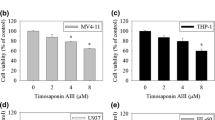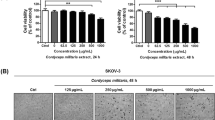Abstract
Tumor necrosis factor (TNF-α) is a pleiotropic cytokine that plays an important role in the control of cell proliferation, differentiation, and apoptosis. TNF-α-induced apoptosis is limited by TAK1-mediated activation of NF-κB (mainly p65-p50 hetrodimer) signaling pathway. We have recently reported that TAK1 regulates phosphorylation of EGFR at Ser-1046/7 through p38 MAPK, which cooperates with NF-κB in TNF-α-induced apoptosis. The present study investigated the effect of gomisins A and N, dibenzocyclooctadiene lignans isolated from the fruit of Schisandra chinensis, on TNF-α-induced apoptosis in HeLa cells. Gomisins A and N strongly promoted TNF-α-induced cleavage of caspase-3 and PARP-1, which are key markers of apoptosis. We found that gomisin N, but not gomisin A, inhibited the TNF-α-induced activation of NF-κB by suppressing the activation of IKKα. Gomisin N also inhibited p38-mediated phosphorylation of the EGFR at Ser-1046/7 and subsequent endocytosis of EGFR, another prosurvival pathway. The findings suggested that gomisin N enhanced TNF-α-induced apoptosis by suppressing of NF-κB and EGFR signaling pathways.






Similar content being viewed by others
References
Štĕrbov H, Ševčíková P, Kvasniková L, Glatz Z, Slanina J (2002) Determination of lignans in Schisandra chinensis using micellar electrokinetic capillary chromatograph. Electrophoresis 23:253–258
He X, Lian L, Lin L (1997) Analysis of lignan constituents from Schisandra chinensis by liquid chromatography-electrospray mass spectrometry. J Chromatogr A 757:81–87
Min HY, Park EJ, Hong JY, Kang YJ, Kim SJ, Chung HJ, Woo ER, Hung TM, Youn UJ, Kim YS, Kang SS, Bae KH, Lee SK (2008) Antiproliferative effects of dibenzocyclooctadiene lignans isolated from Schisandra chinensis in human cancer cells. Bioorg Med Chem Lett 18:523–526
Choi MS, Kwon KJ, Jeon SJ, Go HS, Kim KC, Ryu JR, Lee JM, Han SH, Cheong JH, Ryu JH, Shin KH, Ko CY (2009) Schizandra chinensis alkaloids inhibit lipopolysaccharide-induced inflammatory responses in BV2 microglial cells. Biomol Ther 17:47–56
Oh SY, Kim YH, Bae DS, Um BH, Pan CH, Kim CY, Lee HJ, Lee JK (2010) Anti-inflammatory effects of gomisin N, gomisin J, and schisandrin C isolated from the fruit of Schisandra chinensis. Biosci Biotechnol Biochem 74:285–291
Marek J, Slanina J (1998) Gomisin N. Acta Cryst 54:1548–1550
Opletal L, Sovová H, Bártlová M (2004) Dibenzo[a,c]cyclooctadiene lignans of the genus Schisandra: importance, isolation and determination. J Chromatogr B 812:357–371
Choi YW, Takamatsu S, Khan SI, Srinivas PV, Ferreira D, Zhao J, Khan IA (2006) Schisandrene, a dibenzocyclooctadiene lignan from Schisandra chinensis: structure-antioxidant activity relationships of dibenzocyclooctadiene lignans. J Nat Prod 69:356–359
Kim SH, Kim YS, Kang SS, Bae K, Hung TM, Lee SM (2008) Anti-apoptotic and hepatoprotective effects of gomisin A on fulminant hepatic failure induced by d-galactosamine and lipopolysaccharide in mice. J Pharmacol Sci 106:225–233
Yim SY, Lee YJ, Lee YK, Jung SE, Kim JH, Kim HJ, Son BG, Park YH, Lee YG, Choi YW, Hwang DY (2009) Gomisin N isolated from Schisandra chinensis significantly induces anti-proliferative and pro-apoptotic effects in hepatic carcinoma. Mol Med Rep 2:725–732
Wajant H, Pfizenmaier K, Scheurich P (2003) Tumor necrosis factor signaling. Cell Death Differ 10:45–65
Sakurai H, Suzuki S, Kawasaki N, Nakano H, Okazaki T, Chino A, Doi T, Saiki I (2003) Tumor necrosis factor-alpha-induced IKK phosphorylation of NF-κB p65 on serine 536 is mediated through the TRAF2, TRAF5, and TAK1 signaling pathway. J Biol Chem 278:36916–36923
Perkins ND (2007) Integrating cell-signalling pathways with NF-κB and IKK function. Nat Rev Mol Cell Biol 8:49–62
Takaesu G, Surabhi RM, Park KJ, Tsuji JN, Matsumoto K, Gaynor RB (2003) TAK1 is critical for IκB kinase-mediated activation of the NF-κB pathway. J Mol Biol 326:105–115
Chariot A (2009) The NF-κB-independent functions of IKK subunits in immunity and cancer. Trends Cell Biol 19:404–413
Nishimura M, Shin MS, Singhirunnusorn P, Suzuki S, Kawanishi M, Koizumi K, Saiki I, Sakurai H (2009) TAK1-mediated serine/threonine phosphorylation of epidermal growth factor receptor via p38/extracellular signal-regulated kinase: NF-κB-independent survival pathways in tumor necrosis factor alpha signaling. Mol Cell Biol 29:5529–5539
Shin MS, Shinghirunnusorn P, Sugishima Y, Nishimura M, Suzuki S, Koizumi K, Saiki I, Sakurai H (2009) Cross interference with TNF-α-induced TAK1 activation via EGFR-mediated p38 phosphorylation of TAK1-binding protein 1. Biochim Biophys Acta 793:1156–1164
Singhirunnusorn P, Suzuki S, Kawasaki N, Saiki I, Sakurai H (2005) Critical roles of threonine 187 phosphorylation in cellular stress-induced rapid and transient activation of transforming growth factor-β-activated kinase 1 (TAK1) in a signaling complex containing TAK. J Biol Chem 280:7359–7368
Yasukawa K, Ikeya Y, Mitsuhashi H, Iwasaki M, Aburada M, Nakagawa S, Takeuchi M, Takido M (1992) Gomisin A inhibits tumor promotion by 12-O-tetradecanoylphorbol-13-acetate in two-stage carcinogenesis in mouse skin. Oncology 49:68–71
Irene GM, Thomas EW, Alex AA (2005) Targeting apoptosis pathways in cancer therapy. CA Cancer J Clin 55:178–194
Fulda S, Debatin KM (2006) Extrinsic versus intrinsic apoptosis pathways in anticancer chemotherapy. Oncogene 25:4798–8411
Hayden MS, Ghosh S (2004) Signaling to NF-κB. Genes Dev 18:2195–2224
Coulthard LR, White DE, Jones DL, McDermott MF, Burchill SA (2009) p38 (MAPK): stress responses from molecular mechanisms to therapeutics. Trends Mol Med 15:369–379
Stennicke HR, Salvesen GS (1998) Properties of the caspases. Biochim Biophys Acta 1387:17–31
Wu Y, Zhou BP (2010) TNF-alpha/NF-κB/Snail pathway in cancer cell migration and invasion. Br J Cancer 102:639–644
Acknowledgments
This work was supported in part by Grants-in-Aid for Challenging Exploratory Research (No. 09002374) and for the Knowledge Custer Initiative Toyama/Ishikawa Region (Hokuriku Innovation Cluster for Health Science) from the Ministry of Education, Culture, Sports, Science and Technology (MEXT), Japan, and a grant from the First Bank of Toyama Foundation.
Author information
Authors and Affiliations
Corresponding author
Rights and permissions
About this article
Cite this article
Waiwut, P., Shin, MS., Inujima, A. et al. Gomisin N enhances TNF-α-induced apoptosis via inhibition of the NF-κB and EGFR survival pathways. Mol Cell Biochem 350, 169–175 (2011). https://doi.org/10.1007/s11010-010-0695-z
Received:
Accepted:
Published:
Issue Date:
DOI: https://doi.org/10.1007/s11010-010-0695-z




